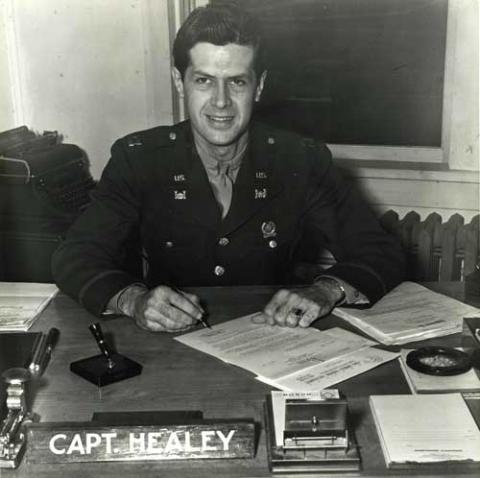John “Jack” Carleton Healey, a colonel in the U.S. Air Force, participated in the Manhattan Project as part of General Groves’ staff in Washington, DC. He continued in the Armed Forces Special Weapons Project after World War II, retiring from the Air Force in 1968. A collection of Healey’s documents, donated to the Atomic Heritage Foundation by Healey’s daughter, Sharon Healey Bartholomew, highlights his contributions to the Manhattan Project.
Early Life
Colonel Healey was born on November 7, 1910, in London, Ontario, Canada to U.S. citizens Anthony Mark and Louise Rita Ryan Healey. After graduating from high school in Battle Creek, MI, Healey enrolled at the University of Michigan, Ann Arbor. There he majored in political science and philosophy. In addition to his studies, Healey was Cadet Major for the Reserve Officers Training Corps and editor of the campus newspaper. During his senior year, Healey served as president of the campus honor society Michigamua; the society’s members included future President Gerald Ford. The strong work ethic and commitment to service that Healey exhibited in college are evident throughout his career.
War Years
After graduating and receiving a commission as second lieutenant in the U.S. Army Reserve in 1935, Colonel Healey spent four years as a newspaper reporter. As rumblings of war shook Europe, the U.S. Army began mobilizing and ordered Healey to active duty. Healey was assigned to the Construction Division of the Army Corps of Engineers and eventually was stationed at Fairbanks, Alaska, where he helped oversee the construction of the Alaska Highway. The highway proved critical not only to the defense of the Aleutian Islands from Japanese attack, but also to the U.S.’s capability to deliver lend-lease goods to its ally, the Soviet Union.
Next, Colonel Healey was assigned to the headquarters of the Manhattan Project in Washington D.C. There he worked on General Groves’ staff during the final two years of the atomic bomb program. As assistant to the director of personnel for the Manhattan Project, Healey was in charge of recruiting the thousands of specialized personnel required to complete the Manhattan Project. The massive Manhattan Project, which required the construction of mammoth factories, ultimately employed more than 130,000 people, all over America.
Later Career
After the war’s conclusion, Healey continued working in the atomic energy program as part of the Armed Forces Special Weapons Project. When the Air Force became autonomous, Healey transferred from the Army to an active-duty role in the Air Force. He served as commander of Kadena Air Force Base in Okinawa, Japan and completed several other tours in the continental United States. The Army Corps of Engineers recognized that Major Healey’s service “was a material benefit to the successful conclusion of the Atomic Bomb Program, and reflects credit upon himself and upon the military service.” General Groves lauded Healey’s efforts, declaring that development of the atomic bomb “could not have been realized but for [his] individual effort.” Healey received the Army Commendation Ribbon and Meritorious Service Award for his military service. He was proud of his participation in and contributions to the Manhattan Project and the Armed Forces Special Weapons Project, as is his family.
Colonel Healey retired from the military in 1968 and moved to Virginia Beach, VA. He went back to school, earned a Master’s degree from William and Mary, and worked in industrial education and training programs. He enjoyed golfing and watching football in his spare time.
Colonel Healey died on May 27, 1996 and is buried at Arlington National Cemetery. John’s daughter Sharon Healey Bartholomew preserved her father’s records from the Manhattan Project in honor of his exceptional life.
Among the documents are detailed command charts from the War Department and numerous letters from General Groves. General Groves’ retirement letter reflects on the boldness and monumental success of the Manhattan Project. Groves describes it as a shining example of American greatness and extends personal thanks to all who were involved. Several letters of commendation written to Healey by his superiors are also included in the collection.





